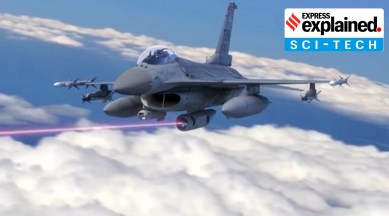Explained: Lockheed Martin delivers pod-sized laser energy weapon to USAF; what is it?
Lockheed Martin has delivered a LANCE system to the Air Force Research Laboratory of the US Air Force for operational testing. What is this energy weapon, and why is this development significant?

US aviation company Lockheed Martin has reportedly delivered a compact directed energy weapon to the Air Force Research Laboratory of the US Air Force (USAF) for operational testing.
What is this energy weapon, known as Laser Advancements of Next-Generation Compact Environments (LANCE), and what are its features? Why is this development significant? What impact will it have on future battlefields? The Indian Express explains.
The LANCE delivery
Breaking Defense, a US website dealing with defence news, revealed in a report Monday (July 11) that Lockheed Martin delivered a LANCE system in compact form to the Air Force Research Laboratory of USAF in February this year.
monthly limit of free stories.
with an Express account.
According to a Lockheed Martin executive quoted by the US website, the LANCE system is one-sixth the size of the other laser energy systems being developed by the company.
Why is this development significant?
The development is significant as it is an acknowledgement that efforts to reduce the size of the laser energy weapon have been successful, and it is now ready to be tested after being mounted on an aircraft.
The fact that the size of the energy weapon has been reduced to that of a pod which can be mounted on a fighter aircraft, or any aircraft for that matter, is an important development.
This laser weapon will give the USAF the capability of shooting down incoming anti-aircraft missiles, thus giving it a crucial edge over its adversaries.
Breaking Defense quoted a Lockheed Martin executive as saying that LANCE is the “smallest, lightest high energy laser of its power class that Lockheed Martin has built to date”. The executive was further quoted as saying it is a critical benchmark in developing an operational laser weapon system in the airborne domain.
While the energy weapon has been developed by Lockheed Martin, the beam control system has been developed by Northrop Grumman, and the pod which will be mounted on an aircraft has been developed by Boeing.
What are the implications of LANCE in future battlefields?
While LANCE has been reduced in size for operational use on aircraft, the system can definitely be put to use on a variety of platforms on land and at sea.
At present, LANCE has been manufactured for a defensive role. However, this research could be furthered to develop an offensive weapon, one that could not only shoot down aircraft and drones, but also be mounted atop ground- and sea-based mobile platforms for offensive roles.
Which countries are actively pursuing development of laser energy weapons?
Apart from the US, several other countries have robust laser energy weapon development programmes. This includes China, Russia, Israel, Germany, France and India.
Israel recently tested its laser weapon to shoot down a drone from the ground.
Russia, meanwhile, said it had tested a laser weapon — Zadira — in Ukraine recently, a claim dismissed by western powers.
While Chinese Navy ships have been photographed with energy weapons onboard, the US Navy officially tested one such system some years back.
India, too, is developing a directed energy weapon named DURGA II, which stands for Directed Unrestricted Ray-Gun Array. It is said to be a light energy weapon of 100 kilowatt capacity.